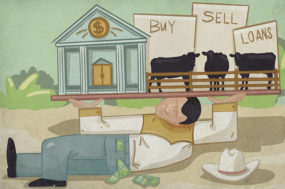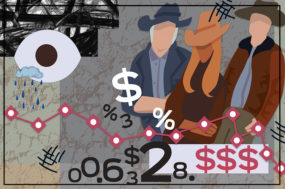“If you go back and look at that data, you see how the movement in Choice carcasses has been,” says John Nalivka, president of Sterling Marketing. “Back in mid-2014, we were [averaging] 75 percent Choice. Generally speaking, through 2010 and all the way up through 2014, that’s essentially where we hovered for Choice.”
In the past few months, the markets have been trending closer around 80 to 85 percent Choice. Speaking specifically to the weekly USDA reports, Nalivka notes the picture is pretty clear.
“That [USDA] data alone pretty well illustrates a pretty significant increase in the Choice cattle,” Nalivka says.
Brian Williams, assistant extension professor in agricultural economics with Mississippi State University, has also taken note of the rise of Choice-graded beef.
“We have seen a substantial increase in the percent of beef carcasses graded Choice over the last couple of years. This year has been trending slightly lower in the percentage of carcasses grading Choice, but it is still well ahead of where we have been historically,” Williams says.
Liquidation and rebuilding
While it might be impossible to determine the exact cause of these trends year-over-year, Nalivka has no doubt the recent droughts have played a huge role.
“I think one of the major contributing factors for this is the fact we had a significant herd liquidation through the drought of 2011 and ’12 but, basically, we took the bottom third off the cattle herd. We went to a 60-year low on our overall cattle numbers and herd sizes. When you liquidate that severely, you always take the bottom cattle out; we did it even more so during those two droughts.”
But we are well past 2012, Nalivka continues. We’re now experiencing the result of how the industry has repopulated the herds.
“As we started to build the herd back – and because prices were pushed into record levels in 2014 and ’15 – there was a lot of attention paid to genetics. People were starting to realize there was a payoff to having really good genetics. People essentially traded out their bull batteries and traded up at a fairly significant cost to a lot better genetics.
We had never seen that in the industry before. I think we’re seeing the result of that. The payoff has been significant, and I think because of how that occurred, it’s something that will just continue moving forward from here.”
Genetic inputs
Likewise, Williams says he would attribute this growth in Choice-graded beef to herd genetics.
“Producers and breeders are continually selecting for animals that exhibit fast growth and excellent carcass characteristics, and I think this is slowly showing up in the carcass grades as well, albeit not to the degree we see as a result of feeding longer,” Williams summarizes.
“I think the main driver behind the increase in the amount of Choice-graded beef has to do with the weight of the cattle going into and out of the feedlot. When cattle prices were so high, feeders were holding onto cattle longer to try to squeeze a little bit more revenue out of each animal. In doing so, they helped push the proportion of cattle grading Choice higher,” Williams says.
Genetics seems to be the cornerstone for the growth of Choice-graded beef, Nalivka has noticed, but management practices focused on meat quality seems to be what brings it all together.
“I think a lot has to do with genetics but also feed management and really paying attention to managing the cattle toward quality [to earn premiums]. We put all those things together, [and] you end up with a cattle herd that’s a lot better for producing higher-quality beef than we’ve ever had in the past,” Nalivka summarizes.
Global demand
What impacts beef domestically almost always has some sort of impact internationally as well. Quality grades are no exception to this rule.
“Quality grades and Choice have obviously had some impact on exports. One of the biggest export items we have is short ribs and, over the last several years, we have continued to see that value of those short ribs continue to climb higher and increase in value. There’s probably something to be said for the value increase being related to the quality increase as well, but short ribs are not an item you would necessarily think you have to have high quality.”
According to Williams, that quality-focused model does impact the beef trade market; however, he most aptly summarizes it as “where things get a bit tricky.”
“We export a lot of our high-quality beef [as well as variety meats] because we produce more of it than we can consume,” Williams says. “At the same time, we import a lot of lower-quality lean beef because we consume more of it than we produce [in the U.S.]. Holding everything else equal, I think as the percentage of carcasses grading Choice increases, we have the potential of boosting both imports and exports.
More cattle grading Choice means fewer cattle grading Select, which is actually reducing our supply of lean beef and boosting our need for imports of lean beef.
“We are [also] producing more higher-quality beef we simply cannot consume while, at the same time, the global middle class is growing and demanding more high-quality proteins such as beef, which is helping to boost our exports.”
With that said, however, Nalivka stresses the importance of focusing on quality-based production practices.
Consistent quality
“I think it’s imperative the beef industry stays focused on quality. It’s hard to keep customers when you have inconsistent quality, and I think the whole key with the beef industry and where we need to continue to move is this whole idea of consistency and quality. If that doesn’t hold together, then the customers will pull away pretty quickly.”
Nalivka feels like domestic customers have grown accustomed to paying a higher price for higher-quality cuts of beef.
“I’ve never known anybody to get too mad about paying more for quality. But when they’ve paid more for quality they thought they were getting but didn’t get, that’s where you run into problems,” Nalivka says.
Consistency is key, and when the beef customers are purchasing consistently meets the value expectation in their minds, price is not as big of a factor. As an industry, Nalivka says, it’s our job to be consistent in quality grades to align with customer expectations.
“Whenever we get into a price slump, we’ve gone through this cyclical herd expansion (where) the prices fall,” Nalivka explains. “I think there’s always been a tendency to respond by letting more of those high-Select cattle into the bottom end of Choice, with hopes that’ll raise the price of the cattle and everybody’ll be good.
“Every time we’ve done that, we’ve slipped cattle into that bottom end of Choice we should not have let into Choice. That’s why we’ve really been focusing on this upper two-thirds Choice, because that’s really where the value is, and that’s where the quality is consistent.”
Overall, Williams sees the rise in Choice-graded beef as a positive for the entire chain of U.S. producers.
“Ultimately, it means we are putting out a higher-quality product. Feedlots are receiving higher prices for Choice carcasses relative to Select, which, although some of the increase in revenue is lost to the additional feed it takes to bring more animals to Choice, it also contributes to improving feeder margins. Part of that, in turn, gets passed on to cow-calf producers in the form of slightly better prices.” 
PHOTO: Industry averages for Choice product have gone up from 75 percent in 2014 to around 85 percent today. Photo by Mike Dixon.
Danielle Schlegel is a freelance writer based in Whitewood, South Dakota.








